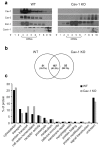Caveolin-1 Endows Order in Cholesterol-Rich Detergent Resistant Membranes
- PMID: 31319608
- PMCID: PMC6680987
- DOI: 10.3390/biom9070287
Caveolin-1 Endows Order in Cholesterol-Rich Detergent Resistant Membranes
Abstract
Cholesterol-enriched functional portions of plasma membranes, such as caveolae and rafts, were isolated from lungs of wild-type (WT) and caveolin-1 knockout (Cav-1 KO) mice within detergent resistant membranes (DRMs). To gain insight into their molecular composition we performed proteomic and lipid analysis on WT and Cav-1 KO-DRMs that showed predicted variations of proteomic profiles and negligible differences in lipid composition, while Langmuir monolayer technique and small and wide-angle X-ray scattering (SAXS-WAXS) were here originally introduced to study DRMs biophysical association state. Langmuir analysis of Cav-1 containing DRMs displayed an isotherm with a clear-cut feature, suggesting the coexistence of the liquid-ordered (Lo) phase typical of the raft structure, namely "cholesterol-rich Lo phase," with a phase fully missing in Cav-1 KO that we named "caveolin-induced Lo phase." Furthermore, while the sole lipid component of both WT and KO-DRMs showed qualitatively similar isotherm configuration, the reinsertion of recombinant Cav-1 into WT-DRMs lipids restored the WT-DRM pattern. X-ray diffraction results confirmed that Cav-1 causes the formation of a "caveolin-induced Lo phase," as suggested by Langmuir experiments, allowing us to speculate about a possible structural model. These results show that the unique molecular link between Cav-1 and cholesterol can spur functional order in a lipid bilayer strictly derived from biological sources.
Keywords: Langmuir films; X-ray diffraction; caveolae; cholesterol-rich microdomains; lipid rafts; liquid order; membrane heterogeneity; membranes/fluidity; membranes/model lipid-rafts; membranes/physical chemistry.
Conflict of interest statement
The authors declare no conflicts of interest.
Figures





References
-
- Lisanti M.P., Scherer P.E., Vidugiriene J., Tang Z., Hermanowski-Vosatka A., Tu Y.H., Cook R.F., Sargiacomo M. Characterization of caveolin-rich membrane domains isolated from an endothelial-rich source: Implications for human disease. J. Cell Biol. 1994;126:111–126. doi: 10.1083/jcb.126.1.111. - DOI - PMC - PubMed
Publication types
MeSH terms
Substances
LinkOut - more resources
Full Text Sources
Medical
Research Materials

